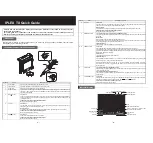
Lake Shore Model 475 Gaussmeter User’s Manual
Background
2-5
2.2
FLUX DENSITY OVERVIEW
2.2.1
What is Flux Density?
A magnetic field can be envisioned as consisting of flux lines (
φ
)
. A unit of flux is called a line. In the cgs system, one
line of flux equals one maxwell (Mx). In the SI system, the flux unit is the weber (Wb), where:
8
8
1
10
10
.
Wb
Mx
lines
=
=
Flux density is the number of flux lines passing perpendicular through a plane of unit area (
A
). The symbol for flux
density is
B
where
B =
φ
/A
. The cgs system measures flux density in gauss (
G
) where
1 G = 1 Mx/cm
2
. The SI system
measures flux density in tesla (
T
) where
1 T = 1 Wb/m
2
.
Flux density is important when magnet systems concentrate flux lines into a specific area like the pole pieces in an
electromagnet. Forces generated on current carrying wires like those in a motor armature are proportional to flux density.
Saturation of magnetic core material is also a function of flux density.
2.2.2
How Flux Density (B) Differs from Magnetic Field Strength (H)
Flux density is often confused with magnetic field strength. Magnetic field strength is a measure of the force producing
flux lines. The symbol for magnetic field strength is
H
. In the cgs system, it is measured in oersteds (
Oe
). In the SI
system, it is measured in amperes per meter (
A/m
):
1
79.58
Oe
A m
=
.
Flux density and magnetic field strength are related by the permeability (
µ
) of the magnetic medium.
B =
µ
H
.
Permeability is a measure of how well a material makes a path for flux lines.
The confusion of flux density and magnetic field strength is also related to permeability. In the cgs system, the
permeability of air (of vacuum) is 1. Therefore,
1 G = 1 Oe
or
B = H
in air. Many people incorrectly assume therefore
that in the cgs system,
B = H
at all times. Adding to the confusion, in the SI system permeability of air is not 1, so
B
is
not equal to
H
even in air.
2.3
HALL MEASUREMENT
The Hall effect was discovered by E. H. Hall in 1879. For nearly 70 years it remained a laboratory curiosity. Finally,
development of semiconductors brought Hall generators into the realm of the practical.
A Hall generator is a solid state sensor that provides an output voltage proportional to magnetic flux density. As implied
by its name, this device relies on the Hall effect. The Hall effect is the development of a voltage across a sheet of
conductor when current is flowing and the conductor is placed in a magnetic field. See Figure 2-6.
Electrons (the majority carrier most often used in practice) “drift” in the conductor when under the influence of an
external driving electric field. When exposed to a magnetic field, these moving charged particles experience a force
perpendicular to both the velocity and magnetic field vectors. This force causes the charging of the edges of the
conductor, one side positive with respect to the other. This edge charging sets up an electric field which exerts a force on
the moving electrons equal and opposite to that caused by the magnetic-field-related Lorentz force. The voltage potential
across the width of the conductor is called the Hall voltage. This Hall voltage can be utilized in practice by attaching two
electrical contacts to the sides of the conductor.
Содержание 475
Страница 16: ...Lake Shore Model 475 Gaussmeter User s Manual 1 6 Introduction 1 4 SAFETY SYMBOLS ...
Страница 25: ...Lake Shore Model 475 Gaussmeter User s Manual Background 2 9 Figure 2 8 Examples of PI Control ...
Страница 36: ...Lake Shore Model 475 Gaussmeter User s Manual 3 10 Installation This Page Intentionally Left Blank ...
Страница 68: ...Lake Shore Model 475 Gaussmeter User s Manual 4 32 Operation This Page Intentionally Left Blank ...
Страница 82: ...Lake Shore Model 475 Gaussmeter User s Manual 6 6 Remote Operation Figure 6 2 Model 475 Status System ...
















































